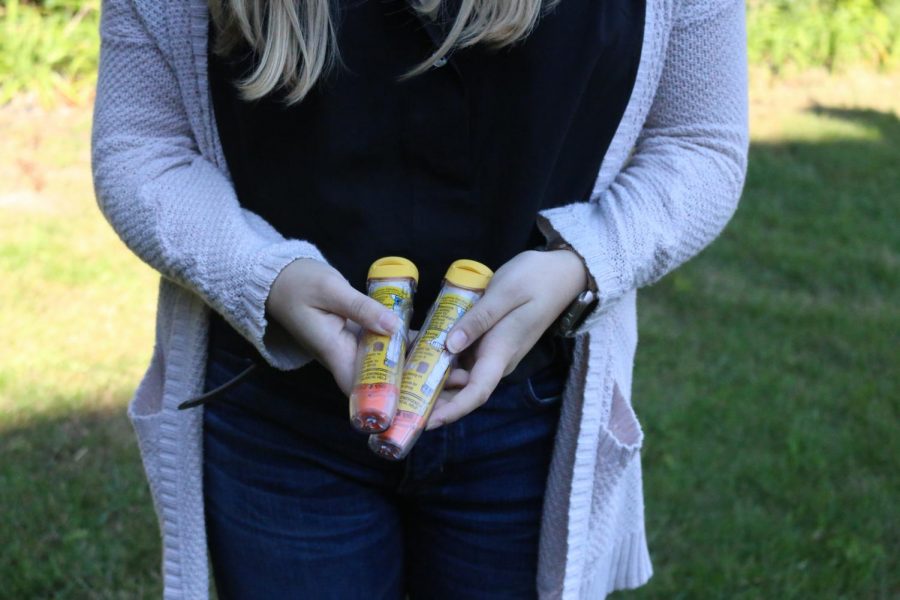Jacob Reilly attributes how frequently he tests his blood sugar to his “type A personality” and how often he eats. Reilly, a junior in the College of Arts & Sciences, has Type 1 diabetes.
Students with health issues like Reilly always have to think one step ahead of their body. What supplies are needed, when and who’s paying are regular hurdles that need to be navigated.
Reilly uses an insulin pump to manage his diabetes. He prefers the pump over insulin pens, the cheaper alternative, because it allows him to have tighter control over his diabetes and give himself more exact insulin doses.
Each month, Reilly has to get insulin from a pharmacy and his insulin pump supplies from his pump company. The strips he gets in a three-month bundle from his pharmacy.
The prescription for insulin and test strips is written by an endocrinologist. The doctor determines how much and what kind of insulin and test strips a patient will need depending on their weight and habits and writes a prescription in line with that estimation, according to the Diabetes Teaching Center at the University of California San Francisco.
The textbook diabetic tests their blood sugar in the morning, at night, before eating and before and after exercise, then injects insulin accordingly, according to the Mayo Clinic. In real life, the schedule can look different depending on the individual and their needs.
A few months ago, Reilly ran out of test strips before he was eligible for his insurance to pay for more.
“I guess the insurance refused to actually put through the order until whatever arbitrary day they had,” Reilly says. “So I ended up having to get test strips from my endocrinologist and buying some over the counter just to get me to that day.”
Reilly estimates that he spent about $120 on test strips out of pocket during that experience.
Fortunately, Reilly’s insurance does partially cover the cost of his supplies. Other diabetics have struggled to adjust to insulin prices, which have been steadily rising over the past several years.
Unlike some pharmaceutical drugs, there is no generic version of insulin. Instead, there are different variations of insulin that differ in onset, peak and duration depending on the patient’s needs. A study released in 2016 revealed that prices tripled between 2002 and 2013, and prices have since continued to rise.
This June, the American Medical Association issued a statement directed toward the Federal Trade Commission and the Justice Department to monitor pricing and market competition between insulin producers.
Lauren Vasko, a sophomore in the College of Business Administration, and Allison Manning, a sophomore in the College of Arts & Sciences, face similar challenges in managing the cost of their food allergies.
Vasko has a severe tree nut allergy that often triggers anaphylaxis, even in small quantities. Manning is severely allergic to sesame seeds and may enter anaphylactic shock if she comes into close contact with her allergen. Anaphylaxis or anaphylactic shock is a severe allergic reaction that, if untreated, prevents the sufferer from breathing. For that reason, they each always carry two epinephrine autoinjectors that need to be replaced after each use.
Since her first anaphylactic reaction when she was 12, Vasko estimates she has had to use her autoinjectors eight times. Each use requires an emergency room visit and a new epinephrine auto-injector prescription from the ER doctor. The cost of each of these adds up.
Although they have insurance, Vasko and her parents still need help navigating the complicated and ever-changing costs of epinephrine. They use coupons and vouchers provided by her allergist. This means she doesn’t have a usual brand of auto-injector she uses.
“Usually our allergist gives us coupons,” Vasko says. “I’ve tried on-brand. I’ve tried generic brands, and I’ve tried Auvi-Q. They did do a recall on it, so I don’t know if it’s still being sold. Those were really tech-savvy because they talk to you and walk you through the steps … I liked it, but they found that each dose (of epinephrine) wasn’t the same.”
Auvi-Q is an EpiPen auto-injector alternative that is “pocket-sized” and available to consumers for no copay, which is just a few of the reasons it was attractive to consumers when it entered the market. In 2015, the parent company Sanofi voluntarily recalled the product because it was found to “potentially have inaccurate dosage delivery,” according to the company website.
Although Auvi-Q reentered the market in 2017 under a different pharmaceutical company, Manning and her family struggled to find a cost-effective autoinjector that they felt safe with after the initial recall. Manning said that she’s fortunate that her family’s insurance plan makes on-brand EpiPens a possibility for her.
“After (the Auvi-Q recall) my family felt more comfortable just staying with the EpiPen brand just because they’re known to work. Because your life is in the hands of this thing, we just didn’t want to risk it,” Manning says.
The lower price of the Auvi-Q auto-injector was so attractive to consumers primarily because of the steadily rising price of the EpiPen two-pack auto-injector over the past several years.
The Centers for Medicare and Medicaid conduct monthly surveys of pharmacies to collect, among other things, pricing data on outpatient drugs. That data is used to calculate the National Average Drug Acquisition Cost per unit of many different pharmaceutical drugs, including EpiPens.
From November 2013 to June 2018, the earliest and latest available data respectively, the NADAC of an EpiPen two-pack auto-injector has risen approximately 200.5 percent.
Other than cost, epinephrine users faced another obstacle in getting their prescriptions filled in recent months. On May 9, the FDA declared a supply shortage alert for EpiPen, EpiPen Jr. and Authorized Generic, a cheaper alternative to EpiPen produced by the company Mylan.
In a statement, Mylan attributed the shortage to its production company, Pfizer. In a statement issued by Pfizer, the company blames “manufacturing constraints” which are in turn affecting supply.
In order to combat the shortage, the FDA and Pfizer worked together to determine an extended expiration date for EpiPens and Authorized Generic autoinjectors currently in circulation. The extended expiration does not apply to EpiPen Jr. The new dates can be found on Pfizer’s website or on the FDA website.
Manning is originally from Boston. She says that living so far away contributed further to her difficulties in planning around the epinephrine shortage. She always keeps a backup pack with her while at school. This year, that trip required her mother to drive an extra 45 minutes to a different pharmacy because her regular one was out of EpiPens.
“Coming so far away from home, I need to have one with me at all times, even one or two,” Manning says. “(The shortage) didn’t affect me too much because my doctor warned us about it, so we just made sure we got what we needed for the school year early in the summer.”
To help ration their auto-injectors, both Manning and Vasko first use Benadryl to see if the antihistamine will be enough to ease their symptoms.
“I usually take Benadryl, and then wait and gauge (the reaction). I can usually tell after a while if it’s going to be pretty serious or not,” Manning says.
“I try not to use (the autoinjector), but it’s always better to be safe than sorry,” Vasko says.
There exist many prescription savings plans that are not insurance, but do provide financial relief for their members. Some require a yearly membership fee, others a service fee and a few are completely free. Although not every over-the-counter drug is covered by each of these plans, many generic drugs are.
For example, Walgreen’s has a prescriptions savings club that has three different tiers. Each tier provides savings based off of which yearly membership fee an individual decides to pay. The membership covers a variety of cold medicines, antibiotics and eye care drugs, among others.






